When it comes to ill-conceived journeys by bike, British author Tim Moore is your man. For his latest book, the author of Gironimo! and French Revolutions decided to tackle what’s become known as the Iron Curtain bike trail (‘Euro Velo 13’), starting in the Arctic Circle and finishing in Bulgaria. What’s more, he wanted to do it with a Soviet-era shopper, the MIFA 900. So naturally, we asked him to send us the worst parts of his journey…
- Cycling fitness: 25 top tips to be a fitter rider
- 5 ways to improve your cycling endurance
- Best bike: what type of bike should I buy?
I was hiding from the August sun under a Florentine café parasol when a journalist phoned to ask me about Euro Velo 13. Our conversation was brief, just long enough for my interviewer to imagine a story headlined, ‘Part-time cyclist knows nothing of new Iron Curtain bike trail.’
The next day I set off for home, having exchanged my usual budget airliner for the four-wheeled fruit of a cheapskate’s midlife crisis: a two-door, eighteen-year-old BMW. It was a ruminative drive, partly because of my dilatory route, and partly because the radiator hose blew off whenever I put my foot down.
Across northern Italy I followed roads I’d cycled two years earlier, retracing the 1914 Giro d’Italia on a 99-year-old bike with wooden wheels. Crossing into France I sought out Alpine climbs remembered, more fuzzily, from my ride around the 2000 Tour de France route. And all the while my thoughts were snagged by the idea of tackling this Iron Curtain Trail: a 10,000km journey through 20 nations, I’d been told, beginning at Norway’s Arctic confluence with Russia.
What a deliciously cool antidote to the wilting south-European summer, periodically enhanced as it was by an antifreeze steam facial whenever I raised the bonnet in a lay-by. I found myself dwelling on a formative three-month tour I’d made around the Eastern Bloc in 1990, just after the Wall came down. As a child of the Cold War, I couldn’t get my head round the fact that one could suddenly amble across the death-strip.
At the age of twelve I’d acquired a wooden-clad, Russian-built short-wave radio, and spent hours twiddling through eerie Soviet interval signals, ten-note loop-tape fanfares interspersed with some fruity-voiced defector announcing: ‘This is Radio Prague, Czechoslovakia.’ I was enthralled and petrified in equal measure.
The Cyclist Who Went Out In The Cold
Back then you’d be packed off to the gulag for smuggling Wrigley’s Juicy Fruit in through the Iron Curtain, or shot dead trying to climb out over it. Now I could ride a bike across it at will. And quite soon, for €56 via German eBay, I had rashly acquired just the bike for the job.
The MIFA 900 made its debut at the Leipzig Trade Fair in 1967, accompanied by whatever passed for a publicity fanfare in the German Democratic Republic – I’m seeing an encirclement of grey-suited men in horn-rimmed spectacles clapping expressionlessly, while a Stasi officer poorly disguised as a podium dolly-bird takes careful note of the cadence and intensity of every individual’s applause.
Superficially, this little open-framed shopper was a match for the compact urban bicycles being launched in the West – but take that first 900 off its jerkily revolving Leipzig rostrum, and you would note the odd shortcoming. The bike lacked gears of any sort, and featured a suicidally rubbish ‘spoon brake’ that had elsewhere died out with the penny-farthing. Glaring structural flaws meant that MIFA 900s regularly broke in half.
Yet, because this was a state-socialist command economy, some three million were produced before the Wall came down. Ignore China, and you will struggle to find any bicycle that betters this total. I did, and failed. And having failed, I wanted one.
On that 1990 trip, I developed a deep maternal affection for the Trabants abandoned on every East European street, headlights shattered and Bakelite doors ajar. Three million Trabants were built, too: another ubiquitous but unloved ugly duckling, another semi-functional, jerry-built symbol of the one-size-fits-all socialist experiment.
I had barely turned a pedal in a year, and my, um, forty-eleventh birthday loomed. Ten thousand kilometres was three times further than I had ever tackled in one go, and I was going to tackle it on an old Communist shopping bike. For the sake of consistency, I set off in the Arctic winter...
- Tim Moore’s account of his ride, The Cyclist Who Went Out in the Cold, is published by Yellow Jersey. Buy it from Amazon
- Follow Tim on Twitter: @mrtimmoore
Day 1: I’ve gone on holiday by mistake. The Arctic Circle
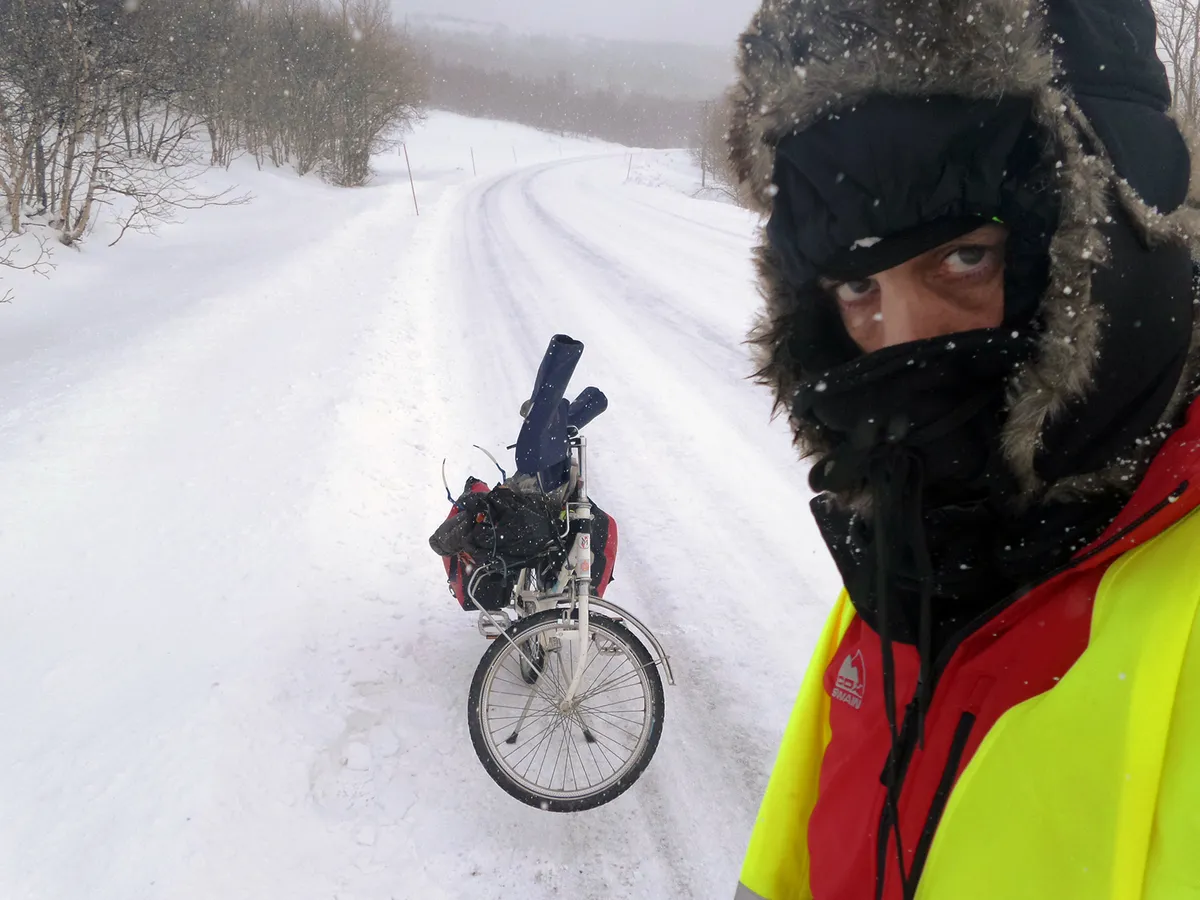
Look into the eyes – not around the eyes. My trip is about four hours old here, and I’m somewhere near the Norwegian/Finnish border, blankly wondering what the actual frosted frick I’ve let myself in for.
It’s starting to get dark and a light blizzard is picking up – in a while I’ll discover my CamelBak mouthpiece has frozen solid. This was the start of what are best described as the most terrible three weeks of my entire life.
Day 18: Tohmajärvi, Finland

Having become genuinely fearful for my mental wellbeing, my wife and son came out for three days while I was halfway through Finland. Here I put their minds at rest by downing a bottle of Lambrini before shutting myself in the infra-red sauna.
Day 24: Petergof, Russia
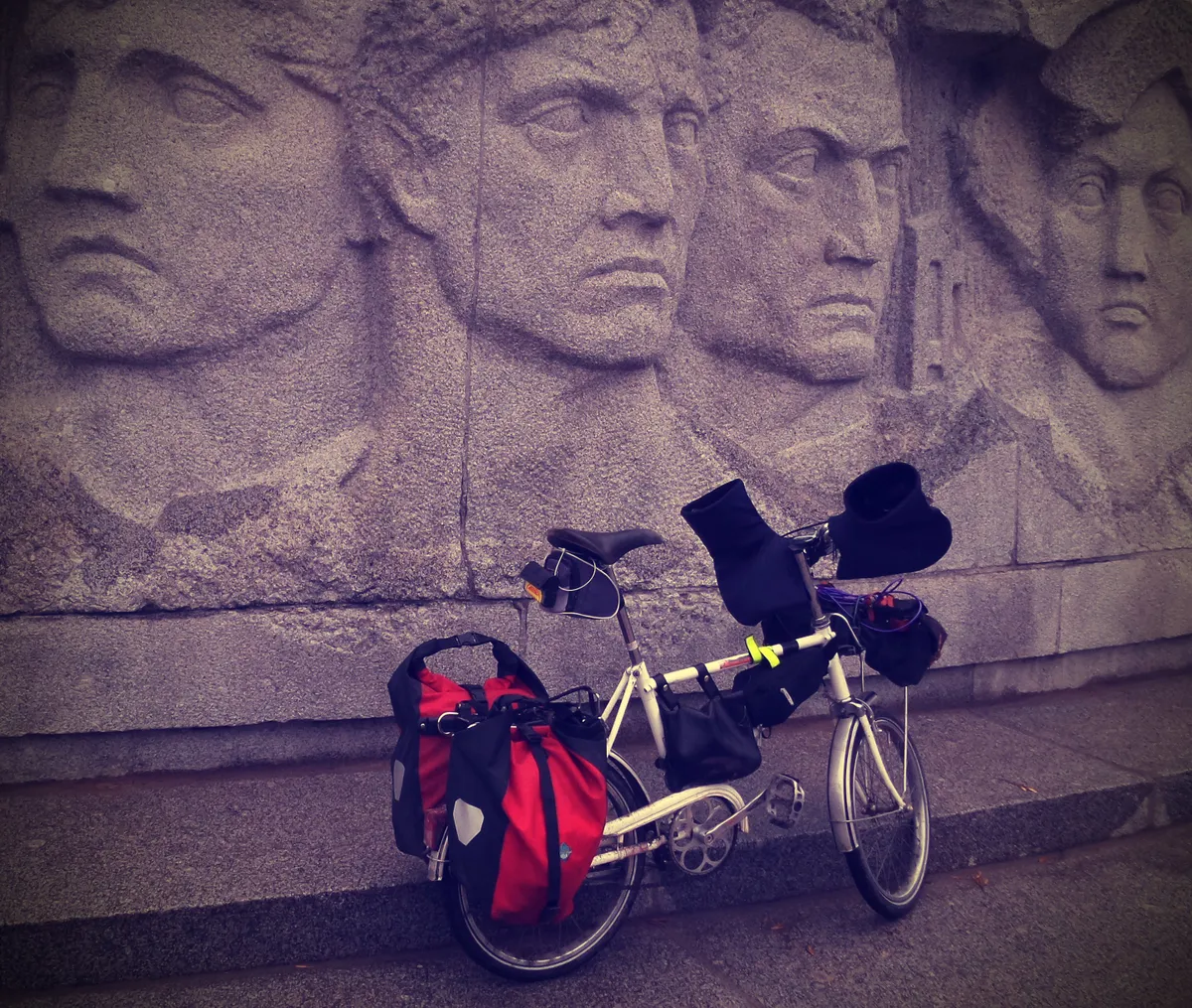
My route here turned inland, to avoid a large swathe of Russia’s Baltic Coast that is sealed off on account of its embarrassment of nuclear and military facilities. Russia offered up an exciting new challenge: drivers who placed no value on their own lives and even less on mine.
I took solace in an alter ego inspired by all the old Commie statues and murals: please to welcome Comrade Timoteya, hero cyclist, on glorious mission to celebrate majesty and large scale of Soviet Union, to admire mighty border defences against rapacity of capitalism and lackey who snivel, to live proud dream of friendship and cooperation in socialist brotherhood. Small bicycle of world unite!
Day 44: Ahlbeck, Germany
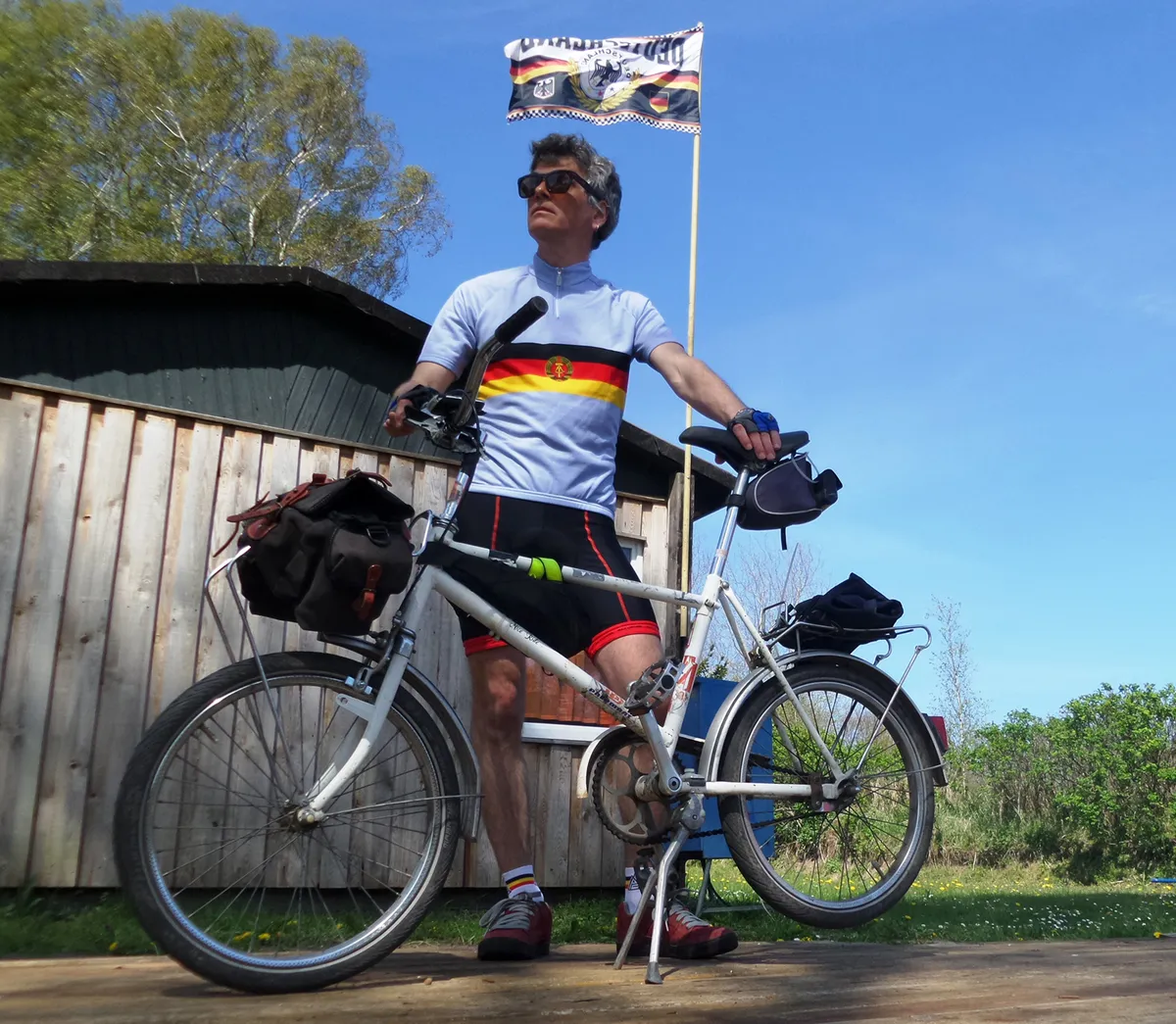
Having just crossed from Poland into what was the GDR, aka East Germany, I celebrate by changing into the replica Communist-era jersey I’d brought along. It’s a strong look I think you’ll agree, and proved a particularly big hit with the more senior locals, one in five of whom would have been Stasi informers. In fact it went down so well that the next morning I set off with the logo hidden under two big strips of gaffer tape.
Day 54: Hötensleben, Germany
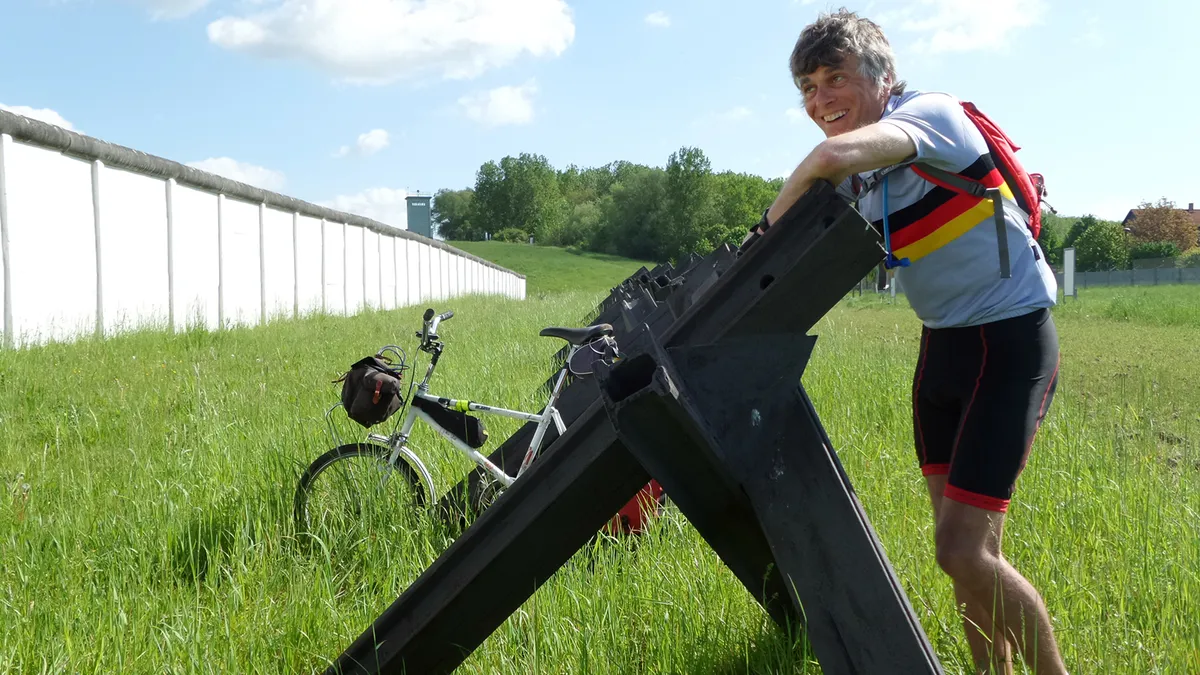
I discovered my camera’s voice-activated shutter feature just before reaching this preserved section of what the GDR regime called ‘The Anti-Fascist Protection Rampart’.
But it was a windy day and I had to really belt out the trigger words: “Shoot! Capture! SHOOT! CAPTURE! SHOOT!” This image preserves my belated moment of realisation, though sensitively omits the rather less entertained dog walkers just out of frame.
Day 78: Near Kalna, Serbia

During my ride I enjoyed a jaunty 58-degree romp up the Celsius scale. And went impressively off the beaten track: EV13 is in large part a theoretical route, and I routinely found myself bumping through derelict border villages and out across open fields.
By now I’ve given up on the GDR jersey, and am rocking the one I wore for my semi-conquest of the 2000 Tour de France route. I haven’t been able to squeeze into it for a decade, but by this stage I’d shed almost 10kg.
Day 83: Near Pirin, Bulgaria
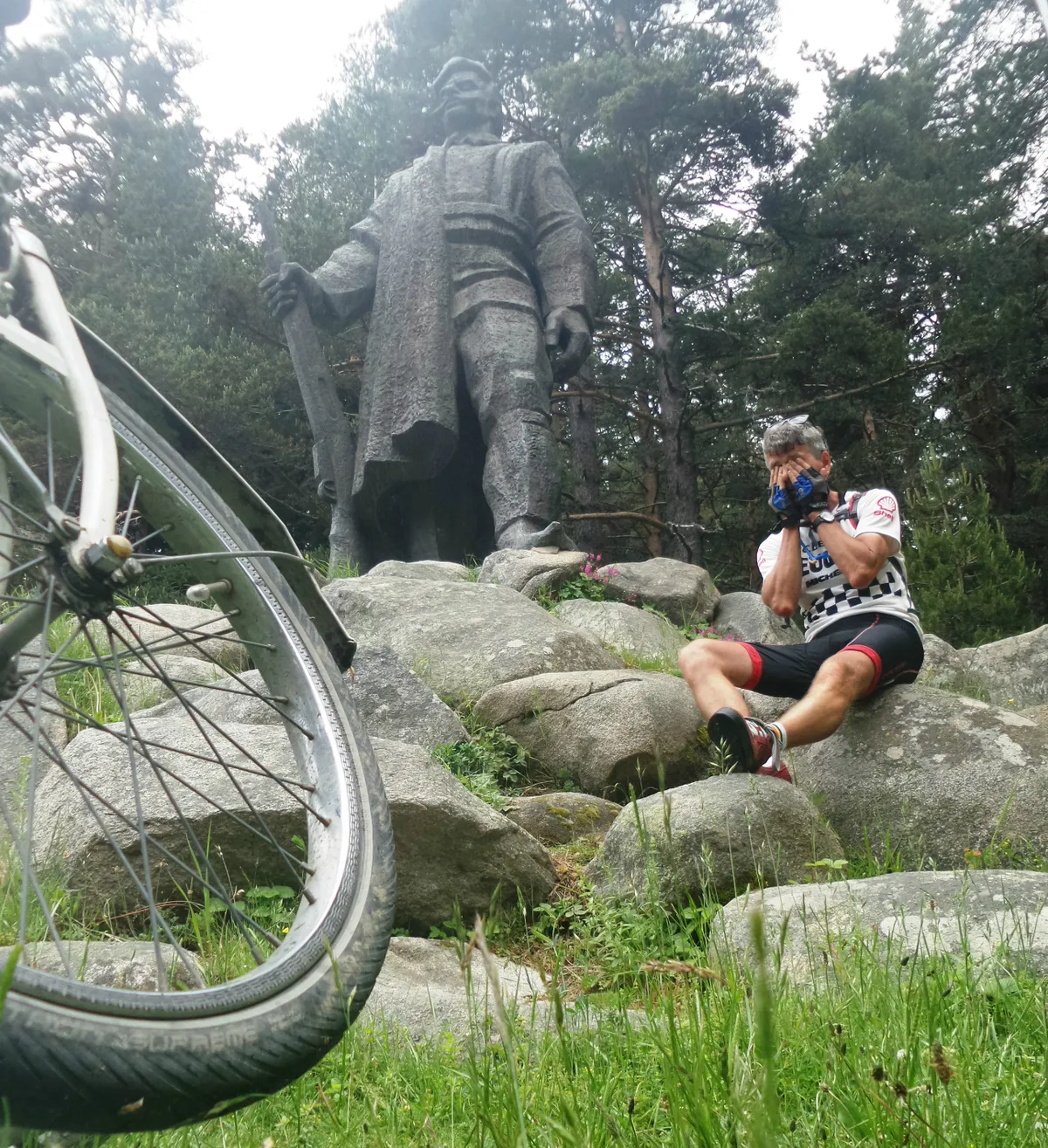
The first half of my Euro Velo 13 journey lay sympathetically prostrate; the second half increasingly didn’t. Here I am in the midst of my most punishing vertical challenge, which for good measure included an apocalyptic rainstorm that strewed my path with large bits of hill.
Cycling up mountains on a shopping bike is, however, possibly more fun than riding down them on one. I never did master that coaster brake. Incredibly, my MIFA only suffered a single puncture – though I did round off a crank, and eroded my headset bearings so impressively that by the end every bend had to be tackled in a series of short straight lines, like the perimeter of an octagon.
Day 87: Tsarevo, Bulgaria – the final curtain

I evidently snipped a few corners along the way, as my Garmin stood at 8,558.4km when I dragged the MIFA up the Black Sea sand. I’d turned those daft pedals 1.7 million times, through 20 countries, but fallen just short of a 100km daily average.
Worse still, I’d very narrowly failed to push my average speed up to 16kmh – better known to those of a certain age and with any sense of basic human pride as 10mph. But those misgivings lay in the future. Propped against that plucky little bike on the beach, there is nothing but neat relief coursing through our grubby, shattered frames.
- Tim Moore’s account of his ride, The Cyclist Who Went Out in the Cold, is published by Yellow Jersey. Buy it from Amazon
- Follow Tim on Twitter: @mrtimmoore
